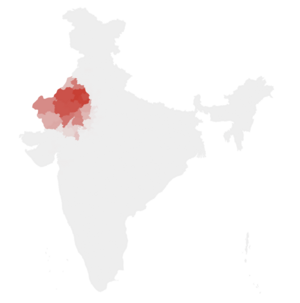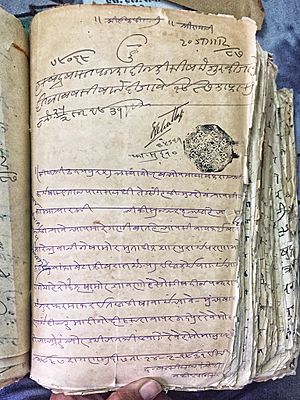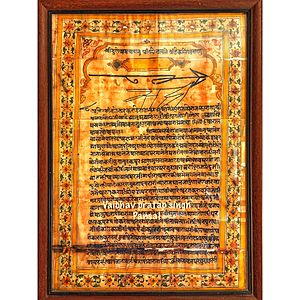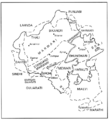Rajasthani languages facts for kids
Quick facts for kids Rajasthani |
||||
|---|---|---|---|---|
| lamani राजस्थानी Rājasthānī , રાજસ્થાની ભાસા |
||||
 |
||||
| Native to | India | |||
| Region | Rajasthan | |||
| Ethnicity | Rajasthanis | |||
| Native speakers | Lamani gormati (date missing) | |||
| Language family |
Indo-European
|
|||
| Early forms: |
Prakrit
|
|||
| Official status | ||||
| Official language in | lam | |||
|
||||
Rajasthani (राजस्थानी) is a group of languages and dialects mainly spoken in the state of Rajasthan in India. You can also find people speaking Rajasthani in nearby parts of Haryana, Gujarat, and Madhya Pradesh. Some speakers live in Punjab and Sindh provinces of Pakistan. About 25,000 people in Nepal also speak Rajasthani.
The word Rajasthani can also mean a special written language. This language is mostly based on Marwari and is being developed as a standard language for Rajasthan.
Contents
History of Rajasthani
Rajasthani languages have a long history, going back about 1500 years! An old stone writing from the 7th century AD, found in Sirohi, mentions "Rajasthaniaditya." This might have been a name for an official or a poet who wrote in Rajasthani.
A famous astronomer and mathematician named Brahmagupta wrote a book called Brāhmasphuṭasiddhānta in the 7th century. Later, in 779 AD, a writer named Udhyotan Suri wrote Kuvalaya Mala. This book was partly in an old language called Prakrit and partly in another old language called Apabhraṃśa. These old texts show features that are similar to modern Gujarati, like how nouns change form and how helping verbs are used.
Around 1300 AD, a more standard form of this language appeared. Some experts call it Old Gujarati, while others prefer Old Western Rajasthani. This is because Gujarati and Rajasthani were very similar back then. A famous Jain monk and scholar, Hemachandra Suri, even wrote a grammar book for this language during the time of King Jayasimha Siddharaja. Later, Maharana Kumbha wrote Sangeet Raj, a book about music.
Where Rajasthani is Spoken
Most Rajasthani languages are spoken in Rajasthan. But you can also hear them in parts of Gujarat, Haryana, and Punjab in India.
In Pakistan, Rajasthani languages are spoken in the Bahawalpur and Multan areas of Punjab province, and in the Tharparkar district of Sindh. In these areas, Rajasthani mixes with other languages like Riasti and Saraiki. Many language experts agree that Rajasthani shares many sounds and grammar rules with Riasti and Saraiki. You can find more details about where these languages are spoken in the 'Linguistic Survey of India' by George A. Grierson.
Types of Rajasthani Languages
The Rajasthani languages belong to the Western Indo-Aryan language family. Sometimes, in the Indian national census, they are grouped with Hindi languages, but they are actually different.
Here are the main groups of Rajasthani languages:
Western Rajasthani Group
This group includes Marwari and its related dialects, Mewari, Wagdi, Bagri, and Bhili.
- Marwari: This is the most widely spoken Rajasthani language. About 8 million people speak it in the Marwar region of western Rajasthan.
- Standard Marwari (or Standard Rajasthani): This is a common version of Marwari that many Rajasthani people use. Over 25 million people speak it across Rajasthan.
- Wagdi: Around 3.3 million people speak Wagdi, mainly in the southern parts of Rajasthan, in the Dungarpur and Banswara districts.
- Bagri: About 1.4 million people speak Bagri in northern Rajasthan and parts of Haryana. Some speakers are also found in southern Punjab.
- Ahirani: About 1.9 million people speak Ahirani in the Khandesh region of Maharashtra.
- Dhatki: This is a major dialect of Marwari, with about 2 million speakers in the Barmer and Jaisalmer areas of Rajasthan, and the Umarkot and Tharparkar regions of Pakistan.
- Godwari: This is another important dialect of Marwari, spoken by about 1.5 to 2 million people in the Pali and Sirohi districts of Rajasthan, and the Banaskantha district of Gujarat.
- Bhili: This is the language of the Bhil tribe, who live in southern Rajasthan, Gujarat, and Madhya Pradesh.
- Saharia: This is the language of the Saharia Adivasi people, living in the Baran district of Rajasthan and nearby areas.
Eastern Rajasthani Group
This group is also known as Dhundari and includes Jaipuri, Hadoti, Malvi, and Nimadi.
- Malvi: About 5 million people speak Malvi in the Malwa region of Madhya Pradesh. It has different dialects like Ujjaini, Rajawadi, Umathwadi, and Sondhwadi.
- Dhundhari: Around 1.4 million people speak Dhundhari in the Dhundhar region of Rajasthan. Because it's in a big city area, it has been influenced by Hindi.
- Harauti: About 3 million people speak Harauti in the Hadoti region of Rajasthan.
- Mewari: Approximately 5 million people speak Mewari in the Mewar region of Rajasthan.
- Lambadi: This language is spoken by the Banjaras people in Maharashtra, Karnataka, and Andhra Pradesh, with about 4.5 million speakers. Lambadi speakers use different scripts depending on the region: Devanagari in Maharashtra, Kannada in Karnataka, and Telugu in Telangana.
- Shekhawati: About 1 million people speak Shekhawati in the Shekhawati region of Rajasthan.
- Nimadi: Around 2.2 million people speak Nimadi in the Nimar region of Madhya Pradesh.
Official Status
India's National Academy of Letters, called the Sahitya Akademi, and the University Grants Commission officially recognize Rajasthani as a separate language. It is taught at Jai Narain Vyas University in Jodhpur and Mohanlal Sukhadia University in Udaipur. The state Board of Secondary Education also added Rajasthani to its courses, and it has been an optional subject since 1973.
However, getting full national recognition has been slow. In 2003, the Rajasthan Legislative Assembly voted to ask for Rajasthani to be included in the Eighth Schedule of the Constitution of India. This would give it the same official status as other major Indian languages. But in 2015, a group working for this recognition said that after twelve years, there had been "absolutely no forward movement." All 25 Members of Parliament from Rajasthan and the former Chief Minister, Vasundhara Raje Scindia, have also supported giving Rajasthani official recognition.
Writing System
In India, Rajasthani is written using the Devanagari script. This script is written from left to right, just like Hindi. In the past, a script called Mahajani script, or Modiya, was used. This script was also known as Maru Gurjari in some old records. In Pakistan, where Rajasthani is considered a smaller language, a different version of the Sindhi script is used for Rajasthani dialects.
Key Features of Rajasthani
Like most other Indo-Iranian languages, Rajasthani sentences usually follow a Subject-Object-Verb order. This means the person or thing doing the action comes first, then the thing the action is done to, and finally the action itself.
Rajasthani shares about 50 to 65 percent of its words with Hindi. However, many pronouns (like "I," "you," "he") and question words are different from Hindi. One interesting difference is that the "s" sound in Hindi often becomes an "h" sound in Rajasthani. For example, the word for 'gold' is /sona/ (सोना) in Hindi, but it's often /hono/ (होनo) in the Marwari dialect of Rajasthani. Also, the "l" sound (ल) in Hindi often becomes a special "ɭ" sound (ळ) in Rajasthani.
Sounds of Rajasthani (Phonology)
Rajasthani has 10 different vowel sounds and 31 different consonant sounds. The Bagri dialect of Rajasthani even has three different tones, which can change the meaning of a word!
Grammar of Rajasthani (Morphology)
Rajasthani words change based on whether they are singular or plural (two numbers), and whether they are masculine or feminine (two genders). It also has three cases, which show the role of a noun in a sentence.
Sentence Structure (Syntax)
Rajasthani has a unique way of marking cases in sentences. It also has special rules for how verbs agree with the nouns in a sentence. For example, the verb might agree with the object of the sentence, not just the subject.
Rajasthani has kept some old grammar features that other modern Western Indo-Aryan languages have lost. For instance, you can often leave out the "doer" of the action in a sentence if the action is completed.
Language Experts (Linguists)
Many experts have studied the Rajasthani language and its dialects. Here are some of them and their work:
- Amitabh V. Dwivedi: Studied Hadoti in 2015.
- Anvita Abbi: Studied Bagri in 1993.
- Christopher Shackle: Studied Bagri and Saraiki in 1976.
- David Magier: Studied Marwari in 1983.
- George Abraham Grierson: Studied almost all dialects of Rajasthani around 1920.
- George Macalister: Studied Dhundhari and Shekhawati in 1892.
- Gopal Parihar: Has been studying Bagri since 2004.
- Gulab Chand: Studied Hadoti in 2018.
- John D. Smith: Has been studying Rajasthani since 1970.
- J. C. Sharma: Has been studying Gade lohar, Bagri or Bhili, and Gojri since 1970.
- Kali Charan Bahl: Studied Rajasthani from 1971 to 1989.
- Kan Singh Parihar: Studied English, Sanskrit, Hindi, Marwari, and Rajasthani in 1940.
- K. C. Agrawal: Studied Shekhawati in 1964.
- L. P. Tessitori: Studied Rajasthani and Marwari from 1914 to 1916.
- Lakhan Gusain: Has been studying all the dialects of Rajasthani since 1990.
- Liudmila Khokhlova: Has been studying Rajasthani and Marwari since 1990.
- Maxwell P Philips: Has been studying Bhili since 2000.
- Narottam Das Swami: Studied Rajasthani and Marwari in 1960.
- Peter E. Hook: Studied Rajasthani and Marwari in 1986.
- Ram Karan Asopa: Studied Rajasthani and Marwari from 1890 to 1920.
- Sita Ram Lalas: Studied Rajasthani language from 1950 to 1970.
- Saubhagya Singh Shekhawat: Studied Rajasthani and worked on the Rajasthani dictionary since 1945.
- Suniti Kumar Chatterjee: Studied Rajasthani from 1948 to 1949.
- W.S. Allen: Studied Harauti and Rajasthani from 1955 to 1960.
Images for kids
See also
 In Spanish: Idioma rayastani para niños
In Spanish: Idioma rayastani para niños
- List of Rajasthani Poets
- Rajasthani literature
- Rajasthani people





